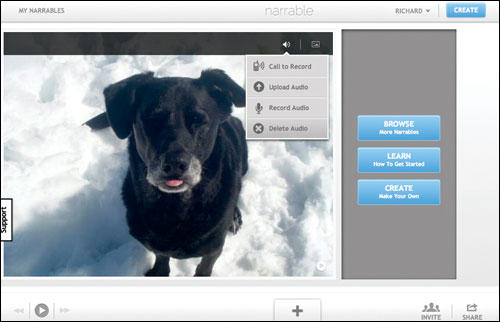
For students who love to write, composing blog entries is a natural—and effective—way to share their stories and ideas with a wider audience. Reluctant writers can have great ideas, too—they just don’t want to write them down. Fortunately, there’s more than one way to tell a story. Here, we’ll examine some excellent video and audio tools and how they can be used to help students craft dynamic content for classroom blogs.
Edited video with SOund
Free tool Wideo.co lets you make short, animated videos in your Web browser. Simply choose from the provided digital cut-outs and drag and drop them onto a canvas to illustrate your video. After arranging the scenes, upload an audio recording to your project—pre-recorded music, a spoken track, or something else.
Students can make their own audio recordings using SoundCloud. Available on the Web and in mobile versions for Android and iOS, SoundCloud includes simple editing tools that remove dead air at the beginning and end of a file. Finished recordings can be saved to a SoundCloud account online, where you can grab an embed code to insert the recording into a blog post.
SoundCloud apps come in handy for a variety of projects. Kids can capture interviews, for example, using the app on their devices. Or they can record classroom presentations or student debates. SoundCloud recordings are downloadable, so the application is ideal for creating those voice-overs for Wideo projects.
Audio slideshows
Animoto is of the best-known tools for making audio slideshows and has long been a classroom favorite. That’s because students quickly create great-looking videos with it. You can make Animoto videos in a Web browser, or on Android and IOS devices. My students have used Animoto to showcase research projects, and the mobile apps are great for highlighting favorite parts of a field trip. All Animoto projects can be embedded into blog posts.
Narrable (pictured above), launched earlier this year, is another audio slideshow application. It’s different from Animoto and here’s how. After your pictures are uploaded in Narrable, you can record narration for each image through your computer’s microphone, or by calling a Narrable access phone number. You can also upload an audio recording stored on your computer. Narrable projects can be shared via email or Facebook, or embedded into a blog.
Unedited video
Editing video is an important exercise, but don’t overlook the value of raw clips. Give a prompt to your students and they can quickly share their thoughts through informal video capture. One I often use is “share your high and low experience from class this week.” In this kind of exercise, the production quality isn’t important. Getting students to express their ideas is what matters.
They can do just that by recording quick YouTube videos using the webcams in their laptops. YouTube apps for Android and iOS enable students to record and post clips on the fly. They can grab the embed codes from YouTube and post the videos on a classroom blog.
This fall, think beyond writing—and give these alternative blogging methods a try.
Narrable | screencast tutorial from School Library Journal on Vimeo.
SoundCloud | screencast tutorial from School Library Journal on Vimeo.



I think videos are more effective than writing articles. Personally, I love watching a video on a particular topic than reading it. Slideshows are also awesome but if you want to show a narrated slideshow, its better to make a video out of it.
I am new to these strategies to share my stories. Thank you for sharing!
Found one more strategy. This would really help me to share my post with users..
Thanks for these awesome strategies. I will sure share them with budding bloggers